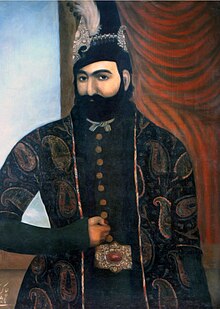Mohammad Shah Qajar
Mohammad Shah Qajar ( Persian محمد شاه قاجار, DMG Moḥammad Šāh Qāǧār ), also Mehmed Mirza Shah ( 1810 - 1848 ), was Shah of Persia from 1834 until his death .
Abbas Mirza's son came from the Qajar dynasty . In 1834, Mohammad Shah ascended the throne as the successor to Fath Ali Shah . His reign began full of hope, as he had taken on a close advisor to his father Abbas Mirza Mirza Abū l-Qāsim Qa'im Maqam . This was probably due to a promise he had made to his father. Qa'im had supported Abbas Mirza in his reform efforts in Azerbaijan and now, as Prime Minister, wanted to tackle the modernization of the administration and the industrialization of Persia with the help of European advisors. Mohammad Shah quickly got tired of the discussions with his prime minister, who often dared to contradict him. After a year he left him curled up in a carpet to suffocate. Obviously he wanted to avoid shedding the blood of his Prime Minister, as he had also promised his father never to shed the blood of his ministers. In his place, he appointed his former teacher, a clergyman and mystic from Yerevan, as prime minister, who ruled the country poorly for 13 years.
During his reign, Babism spread throughout Persia. Its founder, the Persian Sayyid Ali Muhammad, declared in 1844 that the Shiites expected to be the twelfth Imam or Mahdi . The movement of Ali Muhammad, called Der Bab (the "Gate"), spread rapidly across the country, but also met with strong resistance from Shiite orthodoxy and state violence. The Bab was captured as early as 1846.
Mohammad Shah Qajar was married to 15 women who gave birth to 11 sons and 9 daughters. In 1848 he died of gout at the age of 38 . In the same year his eldest son Naser al-Din Shah became the new Shah of Persia.
Under Mohammad Shah, the originally astrological lion-sun motif (before the reign of Mohammad without a sword in the lion's hand) became the national emblem of Persia.
Individual evidence
- ^ Cyrus Ghani: Iran and the Rise of Reza Shah. IBTauris, 2000. p. 3.
- ↑ Archived copy ( memento of the original from September 23, 2010 in the Internet Archive ) Info: The archive link was inserted automatically and has not yet been checked. Please check the original and archive link according to the instructions and then remove this notice.
- ^ Karl Schlamminger, Peter Lamborn Wilson : Weaver of Tales. Persian Picture Rugs / Persian tapestries. Linked myths. Callwey, Munich 1980, ISBN 3-7667-0532-6 , pp. 145-147 and 174-189.
| personal data | |
|---|---|
| SURNAME | Mohammad Shah Qajar |
| ALTERNATIVE NAMES | Mehmed Mirza Shah |
| BRIEF DESCRIPTION | Shah of Persia |
| DATE OF BIRTH | 1810 |
| DATE OF DEATH | 1848 |

